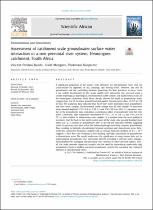| dc.contributor.author | Banda, Vincent Dzulani | |
| dc.contributor.author | Mengistu, Haile | |
| dc.contributor.author | Kanyerere, Thokozani | |
| dc.date.accessioned | 2023-05-08T13:19:32Z | |
| dc.date.available | 2023-05-08T13:19:32Z | |
| dc.date.issued | 2023 | |
| dc.identifier.citation | Banda, V.D., Mengistu, H. and Kanyerere, T., 2023. Assessment of catchment scale groundwater-surface water interaction in a non-perennial river system, Heuningnes catchment, South Africa. Scientific African, 20, p.e01614. | en_US |
| dc.identifier.uri | https://doi.org/10.1016/j.sciaf.2023.e01614 | |
| dc.identifier.uri | http://hdl.handle.net/10566/8899 | |
| dc.description.abstract | A significant proportion of the world's river networks are non-perennial rivers that are characterized by segments of dry, standing, and flowing water. However, the role of groundwater and the controlling elements governing the flow processes in these rivers is not widely documented. In this study, aquifer-river interaction was assessed using a combo of geological, hydrological, environmental stable isotope, and hydrochemical data in the Heuningnes catchment, South Africa. Results showed the depth to groundwater levels ranging from 3 to 10 m below ground level and aquifer transmissivity values of 0.17 to 1.74 m2/day. The analytical data indicated that Na-Cl type water dominates most groundwater and river water samples. Environmental stable isotope data of river samples in upstream areas showed depleted δ18O (-4.3 to -5.12 ‰) and δ2H (-22.9 to -19.3 ‰) signatures similar to the groundwater data, indicating a continuous influx of groundwater into the river water. Conversely, high evaporative enrichment of δ18O (1.13 to 7.08 ‰) and δ2H (38.8 to 7.5 ‰) were evident in downstream river samples. It is evident from the local geological structures that the fault in the north-eastern part of the study area passing Boskloof most likely acts as a conduit to groundwater flow in the NE-SW direction thereby supplying water to upstream river flow, while the Bredasdorpberge fault likely impedes groundwater flow resulting in hydraulic discontinuity between upstream and downstream areas. Relatively low conductive formation coupled with an average hydraulic gradient of 8.4 × 10−4 suggests a slow flow rate resulting in less flushing and high salinization of groundwater in downstream areas. The results underscore the significance of using various data sets in understanding groundwater-river interaction thereby providing a relevant water management platform for managing non-perennial river systems in water-stressed regions. Overall, the study provides important insights into the need for maintaining moderately high groundwater levels in shallow and local groundwater systems for sustaining the ecological integrity of non-perennial rivers. | en_US |
| dc.language.iso | en | en_US |
| dc.publisher | Scientific African | en_US |
| dc.subject | Aquifer-river interaction | en_US |
| dc.subject | Environmental stable isotope | en_US |
| dc.subject | Geological fault | en_US |
| dc.subject | Hydrochemistry | en_US |
| dc.subject | South Africa | en_US |
| dc.title | Assessment of catchment scale groundwater-surface water interaction in a non-perennial river system, heuningnes catchment, South Africa | en_US |
| dc.type | Article | en_US |

